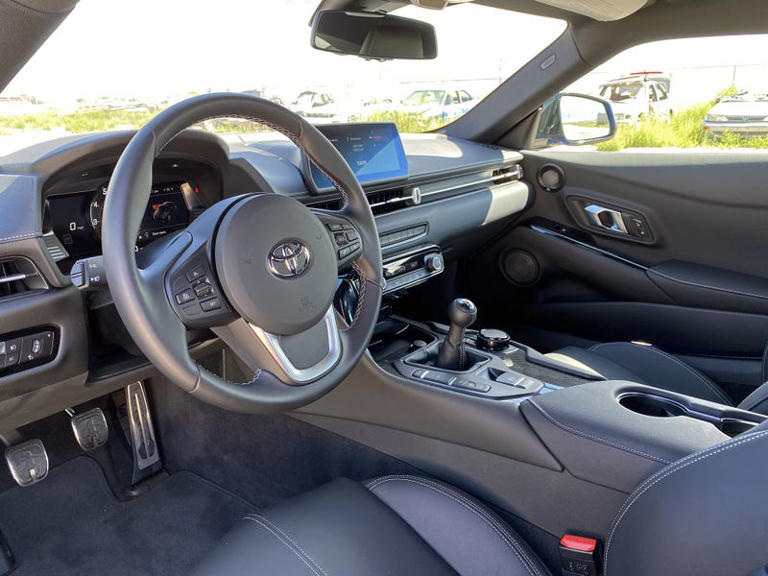If you told me a decade ago that Toyota — the company that brought us the “Camry Effect” marketing campaign — would reconfigure itself to be one of the final bastions for accessible performance in the car industry today, I’d have told you to go grind yourself to the ground.

Here we are now, in 2022, and the world’s largest automaker has found its pulse again with three models that ascend the enthusiast ladder. Toyota is taking fan feedback seriously. Instead of leaving customers hanging, Toyota went back to the drawing board and developed a manual gearbox option for the GR Supra. Granted, it took them a little, but really, I’m simply relieved we’re getting a manual Supra at all.
To be fair, the Supra’s standard eight-speed automatic is fast and accomplishes everything well, but a 0-60 time isn’t the only thing. If it was, I surely wouldn’t be writing this now. After three years of begging, I will joyfully serve as the carrier of good, obvious news: the row-your-own Supra is excellent, boosted by a renewed purpose that we all knew the two-door lacked from the beginning, even if we foolishly attempted to ignore that reality.
Full disclosure: Toyota flew me to Park City, Utah for a day of driving its most anticipated Gazoo Racing-branded cars — the manual Supra and GR Corolla — in and around the Utah Motorsports Campus. I gently begged to forgo that evening’s supper and beverages and continue dehydrating myself inside the Morizo Edition GR Corolla, and a Toyota official kindly said “no.” This truly is a free nation. Next week, we will be bringing you our comprehensive evaluation of the GR Corolla.

According to Toyota, development of the Supra with a manual gearbox began in 2019. It was a cooperative effort, integrating Gazoo Racing engineers with the automaker’s European branch along with gearbox supplier ZF. The GS6L50TZ transmission is a tweaked six-speed that’s available in several international markets on the BMW Z4 sDrive20i. To handle the Supra’s 368 lb-ft of torque, Toyota contributed a brand-new large-diameter clutch and a more robust diaphragm spring. To save even more weight, the GR team eliminated the transmission’s acoustics package and developed a new short-throw shift lever that weighs only 200 grams. After testing three different levers, they settled on the heaviest one since it provided the greatest tactile experience.

In order to achieve a suitably urgent sensation during takeoff and low-gear acceleration, the final drive ratio had to be shortened from 3.15 to 3.46 due to the manual. They do! There was no hint of jerkiness, that startling physical reprimand you feel when you misjudge the bite point and throttle application in a manual you’ve never driven before, and the clutch pedal travel was a touch longer than I’m accustomed to.
It’s lenient, in part because Toyota’s “intelligent” manual gearbox can match engine speeds. Don’t worry – you can turn it off.
Toyota did a nice job of minimizing the ergonomic problems that often arise from cramming a manual transmission into a vehicle that wasn’t originally built with one. Compared to the automatic model, the manual transmission’s center console is somewhat broader, the iDrive controller is located an extra half-inch to the right, and the base of the shifter is nearly two inches closer to the driver. Seating is natural and relaxed, as if the object had always been by the user’s side; there’s never any need to crook an elbow or feel like anything is out of reach.
This is the book that explains everything The chassis of the Supra was modified so that it better matched the vehicle’s new powertrain. The traction-control system has been retuned to reduce the possibility of wheel spin at launch and on curve departure. However, the software hasn’t eliminated the manual’s primary flexibility; a Hairpin+ mode allows for a little amount of differential spin between the rear wheels, which can be exciting when gliding around tight, uphill curves.
Several of the updates are available in automatic versions as well as manual ones. New shock absorbers, “retuned” electronic power steering, and an anti-roll control system are fitted to all 2023 3.0-liter Supras, resulting in a smoother ride and less likelihood of snap-oversteer. The one time I’ve driven an automatic Supra was on a long, boring, straight-shot through a state that doesn’t suffer speeders, so I can’t say I saw a huge difference.

Price-wise, the manual 3.0 Supra is identical to the automatic version: $53,595 for the Base model and $57,745 for the Premium. The latter has leather upholstery, upgraded sound system, and wireless phone charging. The A91-MT Limited Edition costs $59,440 and comes with forged wheels, a strut tower brace in the engine compartment, a dark brown “Hazelnut” upholstery, and a red “Supra” insignia on the trunk. The foregoing costs consist entirely of the $1,095 destination fee.
Manual labor has all the normal drawbacks in terms of efficiency and productivity. The manual-transmission Supra needs an extra 0.03 seconds to reach 60 mph, firmly planting it in the low 4 second bracket. Toyota claims 19/27/21 mpg city/highway/combined fuel economy, which is 4 mpg lower than the automobile. The “just acceptable” two-liter four-cylinder engine, which might have used the six-speed more, is also unavailable.
However, you were probably previously aware of this information. You’re here because those warning signs didn’t even raise an eyebrow. What the fifth-generation Supra should have been all along. Not that it was useless without the guide. But now we’ll never again have to guess what it was.
READ MORE- The 2023 Suzuki SV650 will be available in Italy in three different hues. – Top Future Cars



